
Adelinia grandis, previously known as Cynoglossum grande, is a species of flowering plant in the borage family known as Pacific hound's tongue. It is the only species in the genus Adelinia.

Thunbergia alata, commonly called black-eyed Susan vine, is a herbaceous perennial climbing plant species in the family Acanthaceae. It is native to Eastern Africa, and has been naturalized in other parts of the world.

Vicia hirsuta is a species of flowering plant in the pea and bean family Fabaceae.
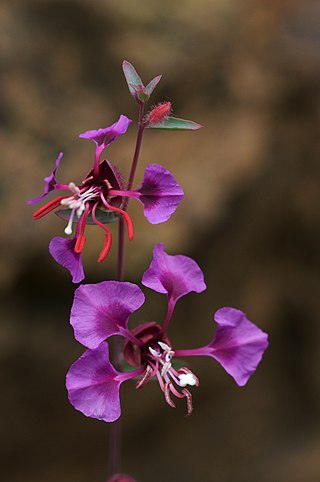
Clarkia unguiculata is a species of wildflower known by the common name elegant clarkia or mountain garland. This plant is endemic to California, where it is found in many woodland habitats. Specifically it is common on the forest floor of many oak woodlands, along with typical understory wildflowers that include Calochortus luteus, Cynoglossum grande and Delphinium variegatum. C. unguiculata presents a spindly, hairless, waxy stem not exceeding a meter in height and bears occasional narrow leaves. The showy flowers have hairy, fused sepals forming a cup beneath the corolla, and four petals each one to 2.5 centimeters long. The paddle-like petals are a shade of pink to reddish to purple and are slender and diamond-shaped or triangular. There are eight long stamens, the outer four of which have large red anthers. The stigma protrudes from the flower and can be quite large. Flowers of the genus Clarkia are primarily pollinated by specialist bees found in their native habitat "Clarkias independently developed self-pollination in 12 lineages."

Epilobium densiflorum is a species of willowherb known by the common names denseflower willowherb, dense spike-primrose or dense boisduvalia. It is native to western North America from British Columbia to Baja California, where it is found in a variety of habitats. This is an erect annual often exceeding a meter in height with fuzzy green foliage. The pointed leaves are up to 8 centimeters long near the base of the plant, and the upper leaves are generally more hairy than the lower. The stem may branch or not. The top of the stem is occupied by a hairy, leafy, densely flowered inflorescence. Each flower has four deeply notched petals in shades of pinkish purple to nearly white with dark veining, each about a centimeter long. The fruit is a cylindrical capsule about a centimeter long.

Epilobium palustre is a species of willowherb known by the common name marsh willowherb. This plant has a circumboreal distribution, and can be found farther south in mountainous areas.

Anthoxanthum occidentale is a species of grass known by the common name California sweetgrass. It is a close relative of the more widely known sweet grass. It is native to the west coast of the United States from Washington to California, where it grows in the coniferous forests of the coastal mountain ranges. This is a rhizomatous perennial grass with leaves up to 30 centimeters long and 1.5 wide. The stem reaches a meter in height with an inflorescence of 7 to 10 centimeters. The spikelets grow on short, wavy stalks and each has three florets with long, protruding stamens during flowering.
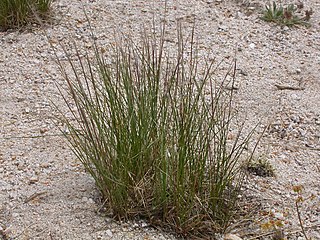
Eriocoma occidentalis is a species of grass known by the common name western needlegrass. It is native to western North America from British Columbia to California, Colorado, and Arizona and in northeastern Mexico (Chihuahua), where it grows in many types of habitat.

Boechera hoffmannii is a rare species of flowering plant in the family Brassicaceae known by the common name Hoffmann's rockcress. It is endemic to the Channel Islands of California, where it is known from only three or four populations on two of the eight islands. A 2005 report estimated a remaining global population of 244 individual plants. It is a federally listed endangered species.
Epilobium pallidum is a species of flowering plant in the evening primrose family known by the common name largeflower spike-primrose. It is native to western United States, where it grows in moist areas in northern California, Oregon, and Idaho. It is an annual herb producing a narrow, upright stem up to 60 centimeters long lined with narrow oval leaves each up to 5 centimeters in length. The inflorescence atop the stem bears several flowers and hairy, leaflike bracts. Each flower has four bilobed petals each up to about a centimeter long and bright pink in color. The fruit is a beaked capsule between 1 and 2 centimeters long containing a row of tiny seeds.

Polemonium occidentale is a species of flowering plant in the phlox family known by the common names western polemonium and western Jacob's-ladder. There are two subspecies. The common ssp. occidentale is native to western North America from British Columbia to Colorado to California, where it can be found in moist areas of many habitat types, including meadows and woodlands. There is also a rare subspecies, ssp. lacustre, which is known only from a total of three counties in Minnesota and Wisconsin, and is found only in white cedar swamp habitat there.

Pyrrocoma carthamoides is a species of flowering plant in the family Asteraceae known by the common name largeflower goldenweed. It is native to western North America from British Columbia to northeastern California to Wyoming, where it is known from grassland, woodlands, forests, barren areas, and other habitat. It is a perennial herb growing from a taproot and producing one or more stems to about half a meter in maximum length, the stems reddish-green and leafy. The largest leaves are at the base of the stem, measuring up to 20 centimeters long, lance-shaped with spiny sawtoothed edges. Leaves higher on the stem are smaller and hairier. The inflorescence is a single flower head or a cluster of up to four. Each bell-shaped head is lined with phyllaries each up to 2 centimeters long. It has many yellow disc florets surrounded by a fringe of yellow ray florets up to 7 millimeters long; ray florets are occasionally absent. The fruit is an achene which may be well over a centimeter in length including its pappus.
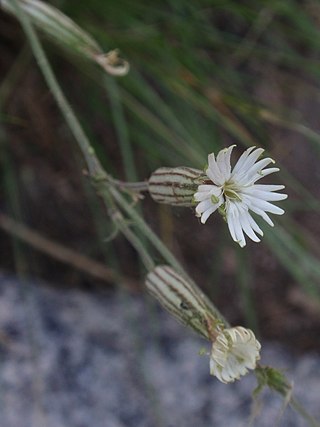
Silene bernardina is a species of flowering plant in the family Caryophyllaceae known by the common name Palmer's catchfly.
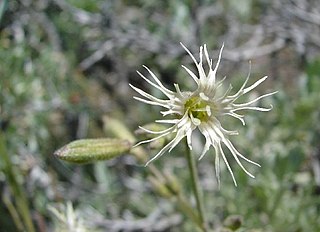
Silene oregana is a species of flowering plant in the family Caryophyllaceae known by the common names Oregon silene, Oregon campion and Oregon catchfly. It is native to the western United States, including the Great Basin, where it grows in habitat such as sagebrush and forests. It is a perennial herb growing from a woody caudex and taproot, sending up an erect, mostly unbranched stem which may be 70 centimeters tall. The lance-shaped leaves are up to 8 centimeters long around the caudex, and shorter farther up the stem. Flowers occur in a terminal cyme and sometimes in leaf axils. Each flower is encapsulated in a hairy, glandular calyx of fused sepals. The five petals are creamy white or pink-tinged in color and each has four to six long, fringelike lobes at the tip.

Stellaria littoralis is a species of flowering plant in the family Caryophyllaceae known by the common name beach starwort. It is endemic to the San Francisco Bay Area and North Coast of California, where it grows in moist coast habitat, such as marshes, bogs, and coastal bluffs. It is a rhizomatous perennial herb producing sprawling, branching stems which are four-angled and hairy in texture, reaching up to about 60 centimeters long. The lance-shaped or pointed oval leaves are up to 4.5 centimeters long and are oppositely arranged in pairs. The inflorescence bears several flowers, each on a short pedicel. The flower has five hairy, pointed green sepals each a few millimeters long. There are five white petals, each so deeply lobed it appears to be two.
Tripterocalyx crux-maltae is a species of flowering plant in the four o'clock family known by the common names Lassen sandverbena and Kellogg's sand-verbena.
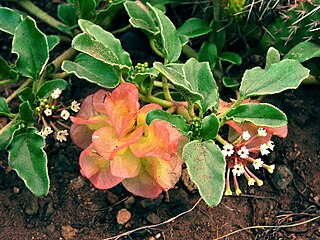
Tripterocalyx micranthus is a species of flowering plant in the four o'clock family known by the common names smallflower sandverbena and small-flowered sand-verbena.

Veronica cusickii is a species of flowering plant in the plantain family known by the common name Cusick's speedwell. It is native to western North America from British Columbia to Montana to northern California, where it occurs in mountain meadows and forests.
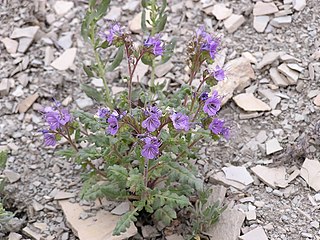
Phacelia argillacea is a rare species of flowering plant in the borage family known by the common names clay phacelia and Atwood's phacelia. It is endemic to Utah in the United States, where it is known only from one canyon in Utah County. It is "one of Utah's most endangered species"; it is "one of the nation's rarest plants" and is federally listed as an endangered species of the United States.

Physaria tenella is a species of flowering plant in the family Brassicaceae known by the common names Moapa bladderpod and slender bladderpod. It is native to western North America from Utah to Sonora, where it grows mainly in desert habitat. This is an annual herb producing several hairy multibranched erect to spreading stems sometimes exceeding half a meter long. The basal leaves are up to 6.5 centimeters long and sometimes toothed, and there are smaller leaves higher on the stem. The inflorescence is a raceme of flowers at the tip of the stem. The mustardlike flower has four orange to bright yellow petals each up to a centimeter long. The fruit is a plump, hairy, rounded capsule containing flat orange seeds.

















